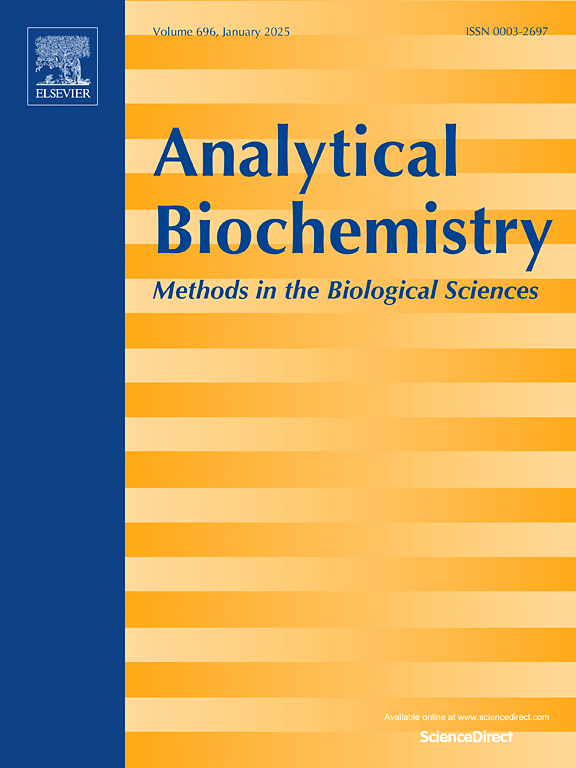Evaluation of active substances in gamboge and their mechanisms for the treatment of colorectal cancer by UPLC-MS/MS integrated with network pharmacology
IF 2.6
4区 生物学
Q2 BIOCHEMICAL RESEARCH METHODS
引用次数: 0
Abstract
Gamboge exhibits anti-colorectal cancer (CRC) activity, however, its active compounds and the underlying mechanisms remain unclear. Herein, a liquid chromatography tandem mass spectrometry (UPLC-MS/MS) method for determining gambogellic acid, β-morellic acid, isogambogenic acid, gambogenic acid, R-gambogic acid, S-gambogic acid, and hydroxygambogic acid in gamboge was established. The key parameters including ion transitions, voltages, LOD, and LOQ were determined, with LOD ranging from 0.8 to 2.0 ng mL−1 and LOQ from 2.7 to 6.7 ng mL−1. The recovery rates were found to be between 95.6 % and 103.5 %. Furthermore, the active compounds were successfully determined, and molecular mechanisms of gamboge in treating CRC were explored. Network pharmacology revealed a “compound-target-pathway” network where the seven compounds could target key proteins, modulate PI3K-Akt and JAK-STAT pathways, and inhibit CRC development. Molecular docking validated SRC, SATA3, PIK3CA, among others, as potential targets for the active compounds in CRC intervention. In conclusion, this method significantly reduces analysis time and improves efficiency relative to existing approaches, making it highly suitable for the effective determination of multiple compounds in the quality control of gamboge materials.

用UPLC-MS/MS结合网络药理学评价藤黄中有效成分对大肠癌的治疗作用及其机制
藤黄具有抗结直肠癌(CRC)的活性,但其活性化合物及其潜在机制尚不清楚。建立了液相色谱-串联质谱法(UPLC-MS/MS)测定藤黄中藤黄酸、β-藤黄酸、异藤黄酸、藤黄酸、r -藤黄酸、s -藤黄酸和羟基藤黄酸的方法。测定了离子跃迁、电压、LOD和LOQ等关键参数,LOD范围为0.8 ~ 2.0 ng·mL-1, LOQ范围为2.7 ~ 6.7 ng·mL-1。回收率在95.6% ~ 103.5%之间。此外,我们还成功测定了其中的活性化合物,并对藤黄治疗结直肠癌的分子机制进行了探讨。网络药理学揭示了一个“化合物-靶标-通路”网络,其中7种化合物可以靶向关键蛋白,调节PI3K-Akt和JAK-STAT通路,抑制结直肠癌的发展。分子对接验证了SRC、SATA3、PIK3CA等作为CRC干预活性化合物的潜在靶点。综上所述,该方法相对于现有方法显著缩短了分析时间,提高了分析效率,非常适用于藤黄药材质量控制中多种化合物的有效测定。
本文章由计算机程序翻译,如有差异,请以英文原文为准。
求助全文
约1分钟内获得全文
求助全文
来源期刊

Analytical biochemistry
生物-分析化学
CiteScore
5.70
自引率
0.00%
发文量
283
审稿时长
44 days
期刊介绍:
The journal''s title Analytical Biochemistry: Methods in the Biological Sciences declares its broad scope: methods for the basic biological sciences that include biochemistry, molecular genetics, cell biology, proteomics, immunology, bioinformatics and wherever the frontiers of research take the field.
The emphasis is on methods from the strictly analytical to the more preparative that would include novel approaches to protein purification as well as improvements in cell and organ culture. The actual techniques are equally inclusive ranging from aptamers to zymology.
The journal has been particularly active in:
-Analytical techniques for biological molecules-
Aptamer selection and utilization-
Biosensors-
Chromatography-
Cloning, sequencing and mutagenesis-
Electrochemical methods-
Electrophoresis-
Enzyme characterization methods-
Immunological approaches-
Mass spectrometry of proteins and nucleic acids-
Metabolomics-
Nano level techniques-
Optical spectroscopy in all its forms.
The journal is reluctant to include most drug and strictly clinical studies as there are more suitable publication platforms for these types of papers.
 求助内容:
求助内容: 应助结果提醒方式:
应助结果提醒方式:


